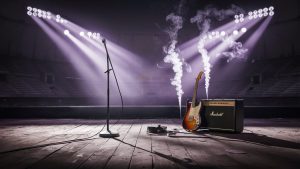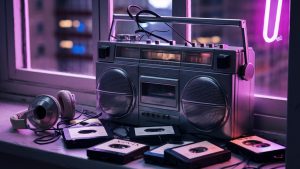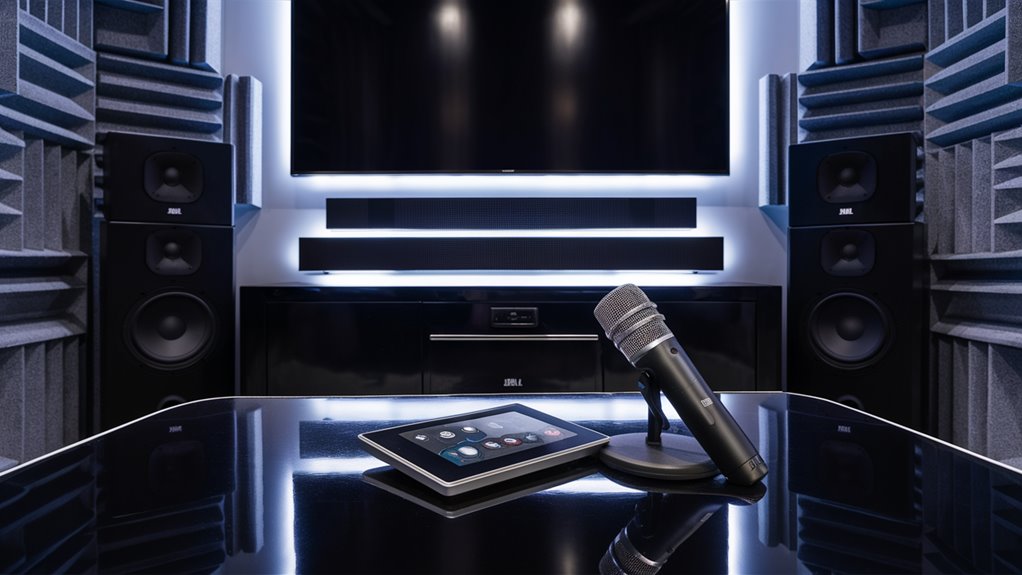
How to Find Karaoke Rooms With Great Sound Gear
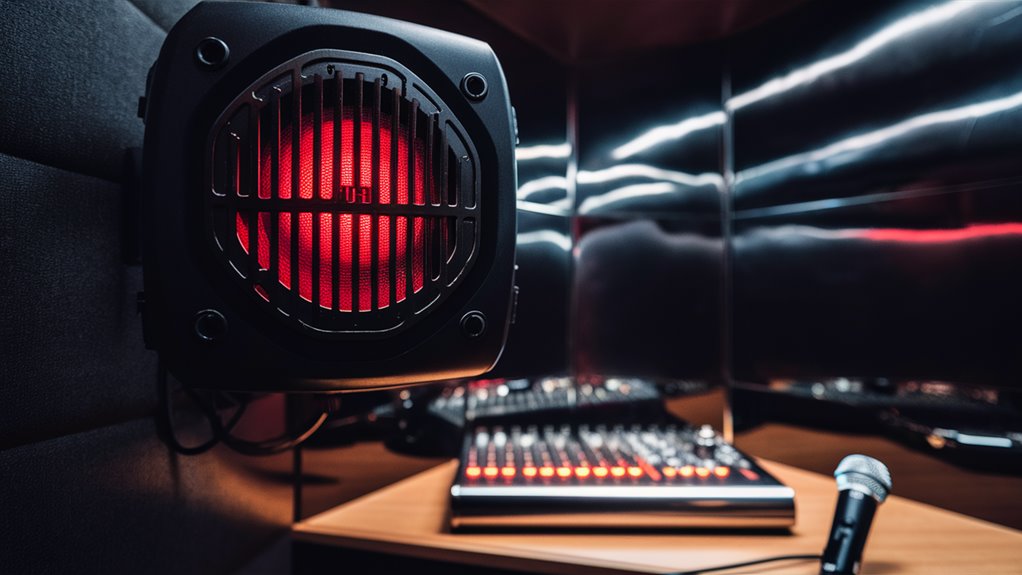
Understanding Sound Equipment
When choosing a karaoke place, pick ones with the best sound stuff. Search for rooms with big-brand speakers such as JBL, QSC, or Yamaha that have power over 1000W. The top places use great mics like Shure SM58s for a clear voice sound.
Sound Proofing and Room Layout
Strong sound proofing is key for great audio. The top karaoke rooms have:
- Wall panels that take in sound
- Bass traps in corners for deep sounds
- Ceiling clouds to cut down echoes
- Walls that block sound from other rooms
Checking Sound Equipment
Key things to look at in sound equipment:
- Screen setups
- Echo control
- Sound adjustment tools
- Volume tuning ease
- Flexibility of EQ
Knowing it’s Great
Before you book, do these steps:
- Read new reviews on sound quality
- Ask to try the sound gear when it’s quiet
- See if the gear is well kept
- Check if the room size matches the speaker power
- Make sure their sound ports work
These steps help ensure you have the best karaoke time with great sound and strong performance.
How to Check Karaoke Room Reviews Online
Evaluating Sound Equipment Quality
The quality of sound gear is key when looking at karaoke spots.
Use review sites like Yelp, Google Reviews, and fun forums for a full picture.
Focus on reviews that speak about clear sound, mic performance, and room audio. Watch for issues like echoes, speaker noise, and screen problems.
Check Recent Reviews
Pay more attention to reviews from the past six months to make sure they’re still true, as sound gear can change.
Look for reviews that detail gear setups, such as amp data, speaker arrangements, and soundproofing.
Reviews that list specific equipment and tech details often tell more about how good a place is.
Looking for Tech Clues
Check reviews that talk about how the system works, song updates, and mic sensitivity.
Look for common problems like delayed sound, uneven volume, or broken gear.
How the place handles tech issues can show how much they care about their equipment and service quality. Go for spots that fix problems fast.
Guide to Discussing Sound Equipment at Karaoke Spots
What to Do When You Call
Call during slow times to talk with tech staff or bosses about their sound gear.
This makes sure they can focus on your questions about their sound setup and what they offer.
Must-Know Equipment Details
Be sure to check major items like:
- Amp power details
- Speaker setups
- If speakers are active
- Top mic models (like Shure SM58 or Sennheiser e835)
Sound Tech and Tools
Dive into their sound tech:
- Using digital sound tools
- Systems that block feedback
- Ways to control volume
- Pro karaoke software
- Music quality (320kbps MP3 or better)
Checking Gear Performance
See how they setup screens for the best show:
- How they place stage screens
- Ways they stop echoes
- Pitch control tools
- How well their timing tools work
Gear Care and Backup Gear
Make sure they look after their gear:
- Regular gear checks
- Backup gear available
- Extra mics
- Extra wires
- Help available during shows
Ensuring They Have Great Speakers
Top Speaker Brands for Karaoke
Great sound starts with top speaker brands.
Big makers like JBL, QSC, and Yamaha make pro-level gear perfect for live singing. These brands are known for great sound and strong output needed for karaoke.
What to Seek in Speakers
A deep look at speaker systems means checking key tech points.
Pro speakers should offer at least 1000 watts with 12-inch or larger parts for top performance.
New models like the JBL PRX800 series and QSC K.2 series are great for clear voices and broad sound.
More Sound Equipment Details
Subwoofer Setup
Pro subwoofer setups using 15-inch or 18-inch parts provide a solid base for sound. These make sure all sounds are smooth.
Monitor and Small Speaker Setup
Smart speaker placement includes:
- Dedicated monitors for performer feedback
- Wall speakers for even sound
- Active or passive speakers based on room needs
Pulling these together creates a top sound spot for pro singing.
Must-Knows on Room Sound Proofing for Karaoke
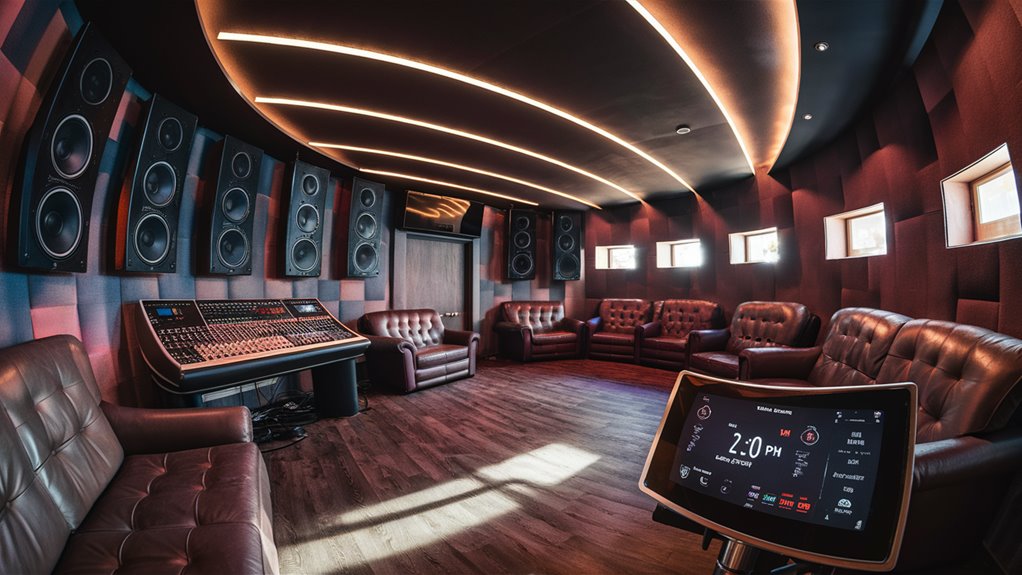
What Goes into Sound Proofing
Sound proofing shapes how the room sounds and how clear voices are.
Key parts are sound panels, bass traps, and diffusers, working together to manage echoes and kill unwanted sound bits.
Key Areas to Check
Wall and Ceiling Work
Wide absorbers on walls should handle sounds between 250Hz to 5kHz.
Ceiling clouds and smart placement of hanging sound panels help control ceiling echoes and keep voices clear.
Handling Bass
Corner bass traps are key for handling deep sounds that can make the music sound muddy.
Right handling of bass ensures voices stay clear and not too deep.
Controlling Echoes
Smart placement of absorbers at main echo points stops harsh echoes while keeping the room’s natural feel.
The mix of absorbing and diffusing sound makes an ideal sound spot that supports clear, pro-quality singing.
Stopping Quick Echoes
Handling echoes from facing walls is key to stop quick echoes, a common sound issue that can mess up voice clarity and overall sound.
The right treatment makes sure smooth sound throughout the room.
Best Setup for Sound Proofing
A good sound proofing setup needs careful thought on:
- Room shape and size
- Where to place materials for the best effect
- Even coverage of absorbing and diffusing
- Smart placement of sound parts
Best Times to Visit Karaoke Spots
Plan Your Visit When It’s Quiet
Plan your visit during quiet times (like 2-5 PM on weekdays) to check everything well.
Why Test Then
When it’s not busy, you can really hear:
- How the room sounds without other noise
- If sound stays in the room
- How the sound system performs at different volumes
- Other noise types
- If air systems affect the sound
Why It’s Important to Test Then
Quiet times let you truly check:
- How the sound equipment is set
- If the mix desk works well
- How speakers perform
- How mics react
- If the equipment is maintained well
Benefits of a Professional Test
Testing when it’s quiet is best. You can:
- Use test sounds to measure properly
- See how sounds hang in the air
- Check how long sounds last
- Spot sound issues
- Find problems like loose wires or damaged speakers
This careful method during quiet times ensures you really know what the karaoke spot can do and how it sounds.
Everything You Need to Know About Karaoke Mic Choices
Professional Mics for Karaoke
Karaoke spots offer different mic options that influence how well you sound and how your singing feels.
Before you book, ask about their mic options to ensure the sound is great.
The Shure SM58 dynamic mic is perfect for loud sounds and blocks feedback, making it ideal for powerful singing and rock.
Mics for Enhanced Shows
Condenser mics capture soft sounds well, lifting slow songs and jazz performances.
Top spots often have wireless setups like the Sennheiser evolution series, letting you move freely while maintaining great sound https://getwakefield.com/
These options ensure voices sound fantastic no matter the song.
Mic Specs and Room Features
Essential Mic Specs
- Sound range: 50Hz to 15kHz
- Dual-mic setups for duets
- Matched pair systems for even sound
- Pop filters for cleaner singing
- Clean-up rules between uses
Additional Room Features
- Wireless connection options
- Feedback blocking tools
- from common pitfalls and costly mistakes
- Various pickup patterns
- Built-in sound processing
- Real-time sound checks
Good spots use the best gear and keep it in top shape, ensuring every singer sounds fantastic.
All About Testing Volume Controls
How to Test Total Volume
Checking the volume control is crucial in setting up sound.
Start with all sliders in the middle. Play a normal sound track at 70% volume to set your base.
Testing Each Sound Route
Check Each Mic Route
Test each mic route separately with these steps:
- Activate each mic input
- Move each slider through its full path
- Check if the left/right balance works
- Test built-in sound effects like echo
- Ensure moves are smooth
Check Music Routes
Testing music routes requires focus on:
- Clarity at all volumes
- How well it mixes with vocal routes
- Clean sound processing across all levels
- Proper sound balance between music and mic routes
Ensuring It Works in Common Ranges
Ensure volume controls work well in commonly used ranges in karaoke.
Check that all components work together well and maintain good sound at all volume levels.

